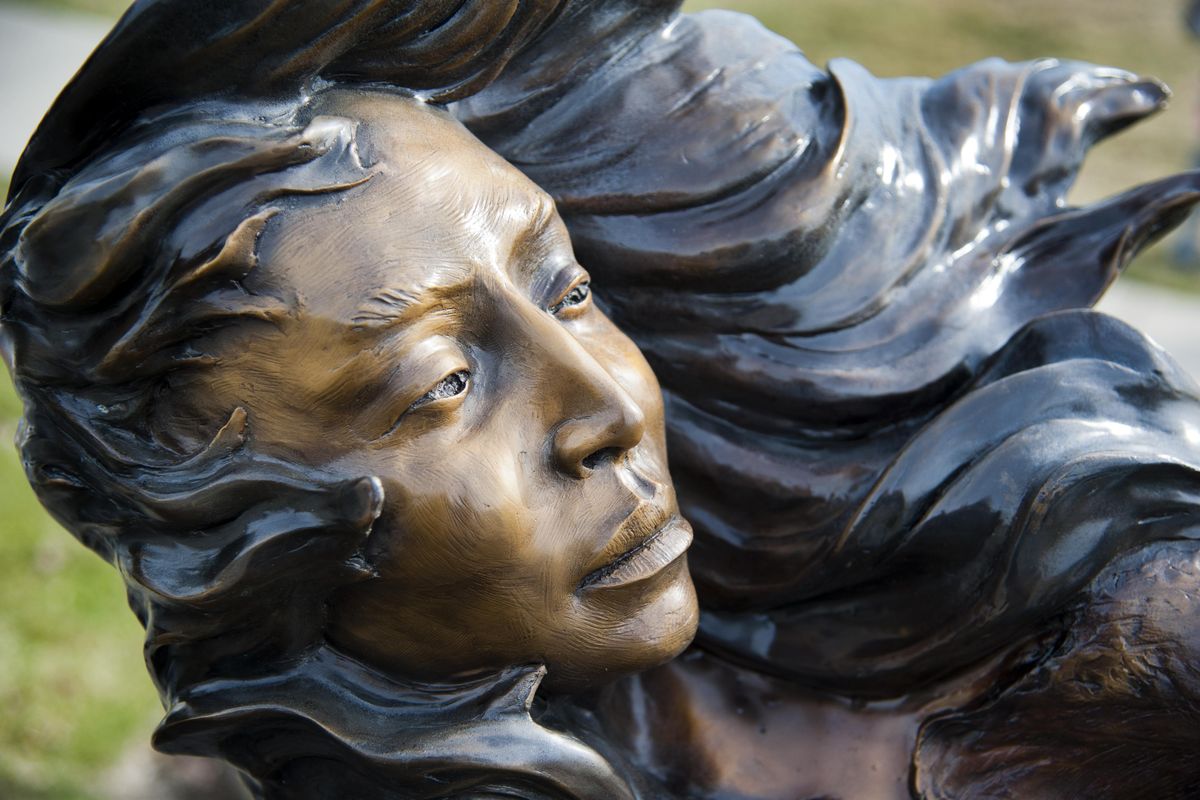Spokane Valley Arts Council creating ‘museum without walls’; plans to donate another sculpture

The Spokane Valley Arts Council more than a decade ago made it a priority to give Spokane Valley an identity through artwork. Fifteen years and five bronze sculptures later, the organization is achieving its goal with plans to donate a sixth sculpture to the city.
Cheney-based artist Richard Warrington – whose work has been featured nationally as well as in Europe, South America, Asia and Canada – is creating the 12-foot-high fabricated aluminum sculpture titled “Heart of the Valley.”
The sculpture will feature a red wave representing the heart of the Valley, surrounded by weaving silver waves representing the people of the Valley.
Warrington said when he spoke with the Valley Arts Council about the piece, he wanted it to be put in a location that gets a lot of traffic, so the reflective piece can be seen at night.
“When you see it you won’t forget it,” he said.
The Valley Arts Council and city officials have yet to find a home for the sculpture, which will be ready in July.
A citizen art department
The Arts Council in 2004 was founded as a nonprofit organization. Although the organization operates independently from the city, it has become sort of a de facto city art department, said James Harken, art director of the Spokane Valley Arts Council.
“We were a bunch of citizens trying to get the arts going in this area,” Harken said. “We wanted to do several things. We wanted to help give the city some identity … something they had that nobody else did. We were trying to start a program and help the artists because they didn’t think they had a market. I think we’ve accomplished a lot of that and the city has picked up on this.”
Harken – former president of the Arts Council – owns a private art collection with more than 3,000 pieces of artwork he’s been collecting since 1969.
For more than 12 years, Harken and his wife have showcased artwork from their collection in the CenterPlace Regional Event Center windows and rotate out the artwork every three months.
“The idea was with the help of the city, we’d try to find a showcase for the art that would be a museum without walls,” Harken said. “We have the art, and the Arts Council has ability to curate it.”
Donating the artwork
The Arts Council since 2009 has donated five bronze sculptures to the city. Two sculptures, “Dance of Sun & Moon” and “Working the Line” were purchased from Colville artist Jerry McKellar, built to a larger scale and installed near the CenterPlace Regional Event Center.
McKellar began making and selling small pieces during his career. At some point, he decided to build monumental pieces, Harken said.
The Arts Council purchased casting rights for “The Berry Picker” from the late artist Nancy McLaughlin’s daughter and installed the sculpture at CenterPlace in 2011. The organization also purchased casting rights from the wife of late artist Ace Powell for “Woman With Horse.”
“At the same time (Woman With Horse) was being built, we contracted with McKellar again to build the two ponies outside of City Hall,” Harken said.
When City Hall opened last year, the Arts Council moved “Berry Picker” from CenterPlace to display outside the new building along with McKellar’s “Coup Ponies” and Powell’s “Woman With Horse.”
“People have been extremely impressed with the sculptures, especially the ones around City Hall,” Harken said. “Until then, people didn’t even know they were around.”
Molding from 3-D image
Creating the large, bronze sculptures is no easy feat.
The sculptures begin as a scaled-down version called a maquet. The Arts Council takes each maquet to a Portland-based foundry, who then scans the maquet with a computer to create a 3-D image that is increased to the requested sculpture size.
The foundry then creates small foam pieces to form a large replica. A hollow wax casting is made, refined and a ceramic mold is made with layers of sand. Wax is poured into the bottom of the ceramic mold and heated in a kiln, which melts the wax and creates a material from the ceramic that can withstand extreme heat of molten bronze. The bronze is then melted and individual pieces are welded together to create the original form. The final step is heating the metal bronze to achieve the desired color of the statue.
The sculpture is then delivered to the site by Spokane Valley-based Rock Placing Co.
“It’s a long process, and these things are meant to last almost forever,” Harken said. “When we started the McLaughlin sculpture, we were almost a year from start to finish.”
The McLaughlin piece – which stands about 8 1/2-feet tall – cost around $12,000 for the computer scan with building and molding costs ranging more than a combined $40,000.
The Arts Council funds the sculptures – which usually sell anywhere from $80,000 to $100,000 – through grant funds received from the city and its annual live arts auction that features 60 to 75 pieces of artwork and draws about 175 to 200 people per year.
“The city is pretty pleased with how we’ve done these things. I think we’ve done a fair job up to date,” he said.
McKellar – who commissioned his western wildlife and Native American themed art sculptures for several U.S. cities – said it’s a great honor for his artwork to be displayed in the Valley, especially pieces purchased for a permanent collection.
“The Arts Council has been very helpful to my career, so I will be supporting them as long as I can,” McKellar said.
Overall, there’s growing interest in western wildlife art, but Spokane has always presented a somewhat difficult market for artists to sell work, said McKellar.
However, with the help of the Arts Council, it’s changing, McKellar said.
“The Arts Council has kind of picked up the ball and run with it,” he said.